 (1)
(1)
式中,uxab 为ab 坐标系下的逆变器输出电压矢量;iab 为ab 坐标系下的逆变器输出电流矢量;egab 为ab 坐标系下的电网电压矢量;L为滤波电感;R为滤波电感上的寄生电阻。根据前向欧拉法,式(1)可以被离散化为
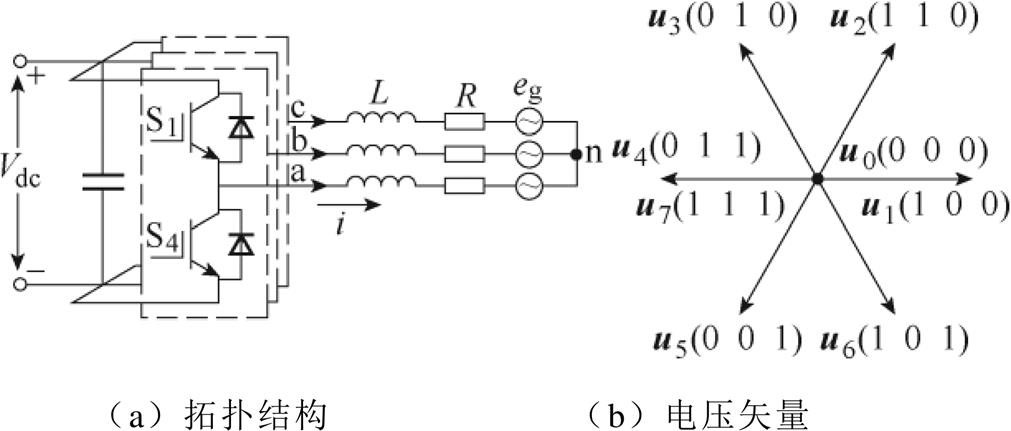
图1 电压源逆变器的拓扑结构及电压矢量
Fig.1 Topology and basic voltage vectors of VSI
摘要 为消除并网逆变器模型预测控制对系统参数的依赖,该文提出一种基于双矢量的并网逆变器无模型预测电流控制(MFPCC)策略。该策略通过计算和存储上一时刻双矢量作用下的电流梯度,更新剩余6个未使用矢量的电流梯度,并结合当前时刻的电流采样值,实现未来时刻的电流预测;进一步利用电流预测的价值函数选取合适的电流梯度及其作用时间,从而得到下一时刻最优的电压矢量。该方法不依赖于任何系统参数、计算量小,且消除了传统MFPCC策略中电流梯度更新停滞现象,降低了输出电流谐波。最后,通过仿真和实验验证了所提方法的有效性和优越性。
关键词:并网逆变器 无模型预测电流控制 双矢量 电流梯度更新
随着光伏、风电和储能等技术的快速发展,并网逆变器成为了新能源发电系统接入电网的关键设备[1]。为了降低新能源发电对电网的影响,并网逆变器的输出电流需要满足快动态响应、低总谐波畸变率(Total Harmonic Distortion, THD)等并网要求,多种控制方法随之发展。其中,模型预测电流控制(Model Predictive Current Control, MPCC)方法具有响应速度快、约束处理简单、多目标控制能力强等优点,已广泛用于并网逆变器的输出电流控制[2]。然而,基于MPCC的电流控制技术,其输出电流性能对逆变器并网参数变化十分敏感[3]。
为了降低MPCC对系统参数的敏感性,已有学者提出基于参数辨识和基于扰动观测的MPCC方法。文献[4]采用一种基于反电动势的模型参考自适应方法对系统电感进行在线辨识。文献[5]提出一种遗忘因子最小二乘法,用于跟踪PWM整流器功率预测控制的时变电感。文献[6-7]提出基于滑模观测器的参数辨识方法,改善了传统辨识方法在电网不平衡条件下的辨识准确性。文献[8-9]通过应用扰动观测器估计并补偿了由失配参数引起的时变扰动,提高了MPCC的鲁棒性。虽然这些方法有效地降低了MPCC的参数敏感性,但其需要设计复杂的参数,存在实现复杂及计算负担大等问题。
近年来,基于电流梯度的无模型预测电流控制(Model-Free Predictive Current Control, MFPCC)策略得到了广泛的关注。该方法通过采样获得电流梯度,并将其存储在查询表(Look-Up Table, LUT)中用于电流预测[10]。然而,该方法的控制性能依赖于电流梯度的准确性。在文献[10]的实施过程中只能通过电流采样更新应用矢量作用下的电流梯度值,其他未应用矢量作用下的电流梯度保持旧值,无法实时更新,该现象称为停滞现象,其将导致电流预测不准确,进而产生电流尖峰。文献[11]提出了一种基于特定更新频率的电流梯度更新方法,在该方法中,如果某个电流梯度在规定的更新时间内没有被更新,它对应的矢量将在下一个控制周期被强制使用,电流梯度也会被随之更新。这种方法频繁使用非最优电压矢量,会导致输出电流性能下降。文献[12]利用过去三个控制周期获得的电流梯度对剩余的电流梯度进行更新。同时,该方法只有在过去连续三个控制周期应用的矢量不同时才会生效。文献[13]简化了数学模型,建立了前后两个控制周期的电流梯度关系,并利用这种关系更新剩余的电流梯度。该方法在连续两个控制周期应用的矢量相同时会失效。综上所述,现有文献不能完全消除停滞现象,并且是针对单矢量(Single-Vector, SV)提出的,存在电流纹波大的问题。虽然文献[14-15]提出了基于多矢量的MFPCC,降低了电流纹波,并通过在每个控制周期设置多个采样点,更新多个应用矢量作用下的电流梯度,但停滞现象仍不能被消除。目前,电流梯度实时更新方法仍需被研究;多矢量MFPCC下如何计算、更新多个应用矢量的电流梯度,尚未见讨论。
本文针对并网逆变器提出了一种基于双矢量(Double-Vector, DV)的MFPCC方法。由于每个控制周期采用了两个电压矢量,该方法可以有效改善电流纹波和THD。根据电压矢量持续时间与价值函数成反比的原理,计算得到每个电压的持续时间。此外,该文提出一种改进的电流梯度更新方法,完全消除了停滞现象。在所提的更新方法中,根据两个应用电压矢量的持续时间以及其电流梯度关系,计算获得两个应用电压矢量的电流梯度;并建立了应用电压矢量电流梯度和剩余电压矢量电流梯度的数学关系,计算得到剩余6个电压矢量的电流梯度。
典型的L滤波并网逆变器结构简单,易于控制,其拓扑结构及产生的8个基本电压矢量如图1所示。L滤波的三相并网逆变器在ab 静止坐标系中的数学模型可以表示为
 (1)
(1)
式中,uxab 为ab 坐标系下的逆变器输出电压矢量;iab 为ab 坐标系下的逆变器输出电流矢量;egab 为ab 坐标系下的电网电压矢量;L为滤波电感;R为滤波电感上的寄生电阻。根据前向欧拉法,式(1)可以被离散化为

图1 电压源逆变器的拓扑结构及电压矢量
Fig.1 Topology and basic voltage vectors of VSI
 (2)
(2)
其中

式中,Ts为控制周期;Diab(k)为电压矢量uxab(k)作用下的电流梯度;iab(k)为k时刻逆变器输出的电流;iab(k+1)为k+1时刻逆变器的预测电流;egab(k)为k时刻电网电压矢量。根据式(2)可以得知,MPCC的电流预测依赖于逆变器参数的准确性。然而,逆变器的参数可能因测量误差而不准确,或因工作条件的变化而变化。这种参数的不确定性会导致电流预测误差,降低电流性能。
为了消除模型参数对MPCC的影响,基于电流梯度的MFPCC被学者提出[10],该方法利用采样得到的电流数据替代了传统的预测模型。其中,式(2)中的电流梯度可以改写为
 (3)
(3)
在MFPCC中,采样获得电流梯度与应用的电压矢量一一对应,并被存储在LUT中用于电流预测。因此,k+1时刻的预测电流可以表示为
 (4)
(4)
传统电流梯度更新方法如图2所示,传统的MFPCC方法在每个控制周期只能更新当前电压矢量作用下的电流梯度值,对于未使用的矢量,其对应的电流梯度值则无法更新,这种更新停滞现象将导致预测的不准确。此外,其在每个控制周期只采用一个电压矢量,导致逆变器开关频率低、输出电流纹波大。

图2 传统电流梯度更新方法
Fig.2 The conventional current gradient updating
为了解决上述问题,本文提出了一种改进的DV-MFPCC,所提方法包括四个部分:双电压矢量MFPCC的基本原理、电流梯度更新方法、停滞消除及所提DV-MFPCC的实现过程。
根据伏秒平衡原理,使用8个基本电压矢量生成12个电压矢量组合,并表示为
 (5)
(5)
式中,usi为电压矢量组合,i {1, 2,…, 12},12个电压矢量组合分别由(u0, u1),(u7, u2),(u0, u3),(u7, u4),(u0, u5),(u7, u6),(u1, u2),(u2, u3),(u3, u4),(u4, u5),(u5, u6),(u6, u1)合成;um和un为两个基本电压矢量;t1,um和t2,un分别为um和un的作用时间。
{1, 2,…, 12},12个电压矢量组合分别由(u0, u1),(u7, u2),(u0, u3),(u7, u4),(u0, u5),(u7, u6),(u1, u2),(u2, u3),(u3, u4),(u4, u5),(u5, u6),(u6, u1)合成;um和un为两个基本电压矢量;t1,um和t2,un分别为um和un的作用时间。
由于电压矢量的作用时间与其价值函数成反 比[16-17],t1,um和t2,un可以表达为
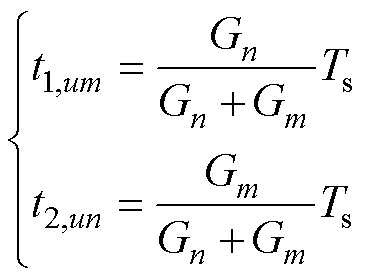 (6)
(6)
式中,Gm和Gn分别为um和un的价值函数。所提方法在每个控制周期选择两个基本电压矢量。基于所选电压矢量对应的电流梯度及其作用时间,可以计算出预测电流。因此,k+1时刻和k+2时刻的预测电流可以分别表示为
 (7)
(7)
 (8)
(8)
式中,iab(k+2)为k+2时刻逆变器的预测电流;Diumab为基本电压矢量um对应的电流梯度;Diunab为基本电压矢量un对应的电流梯度。
在执行MFPCC时,需要将12个电压矢量组合对应的电流梯度代入式(8),并将得到12个预测电流代入式(9)所示的价值函数G进行评估,最终选择使价值函数最小的电压矢量作为最优电压矢量,并将其作用在下一个控制周期。
 (9)
(9)
式中,G为控制系统价值函数; 和
和 分别为a、b 坐标系下的电流参考值。
分别为a、b 坐标系下的电流参考值。
当k-1时刻和k时刻应用的电压矢量组合由两个基本电压矢量um和un组成时,根据式(3)获得的电流梯度Diab(k-1)也由两个电流梯度Dimab(k-1)和Dinab(k-1)组成。此时,式(3)可以重新表示为
 (10)
(10)
由于电流梯度Dimab(k-1)和Dinab(k-1)不能直接根据式(10)计算得到,因此需要建立新的关系。
1)不同电压矢量对应的电流梯度关系
根据式(2)可以将Dimab(k-1)、Dinab(k-1)分别表示为
 (11)
(11)
 (12)
(12)
将式(11)和式(12)相减可以得到
 (13)
(13)
为了消除式(13)中的电感参数,Dimab(k-2)和Dinab(k-2)之间的关系可以同理表示为
 (14)
(14)
将式(13)和式(14)相除可以得到
 (15)
(15)
2)电流梯度更新
Dimab(k-1)和Dinab(k-1)可以视为两个待求解的未知数。根据式(10)和式(15)两个方程,方程的解可以表示为
 (16)
(16)
 (17)
(17)
同理,剩余6个矢量对应的电流梯度和两个应用矢量对应电流梯度之间的关系也可以建立。剩余矢量的电流梯度计算可以表示为
 (18)
(18)
式中,uy为剩余的6个矢量;Diy为剩余矢量对应的电流梯度,其中y≠m和n;um,n为应用矢量um或un;Dim,nab(k-1)为电流梯度Dimab(k-1)或Dinab(k-1)。
根据式(16)~式(18)可知,电流梯度的计算会受公式分母数值的影响。本节从应用矢量um和un的电流梯度计算和剩余矢量uy的电流梯度计算两种情形进行分析。
1)情形1:um和un的电流梯度(Dimab(k-1)和Dinab(k-1))计算
当式(16)和式(17)的分母不为0时,其可以进一步化简为

 (19)
(19)

 (20)
(20)
当式(16)和式(17)的分母趋近于0时,电流梯度的更新将不再生效。以下四种情况可能导致其分母趋近于0,分别为u0b=u1b,u2b=u3b,u4b=u7b和u5b=u6b。根据式(13)可知,相同的坐标分量(即um(k-1)=un(k-1))会使电流梯度相同(即Dim(k-1)= Din(k-1))。由于Dim(k-1)=Din(k-1)以及t1,um+t2,un=Ts,根据式(10)可以计算得到
 (21)
(21)
因此,应用矢量的停滞效应被消除。
2)情形2:uy的电流梯度 (Diyab(k-1)) 计算
当式(18)的分母不为0时,其可以进一步化简为
 (22)
(22)
当式(18)的分母趋近于0时,电流梯度的更新也不再生效。以下九种情况可能导致其分母为0,分别为u0b=u1b,u2b=u3b,u4b=u7b,u5b=u6b,u0a=u7a,u0b=u7b,u1b=u4b,u3a=u5a 和u6a=u2a。由于相同的坐标分量会使电流梯度相同,式(18)可以表示为
 (23)
(23)
因此,剩余矢量的停滞效应也被消除,所提电流梯度更新方法如图3所示,所有电流梯度均可以在一个控制周期被更新。
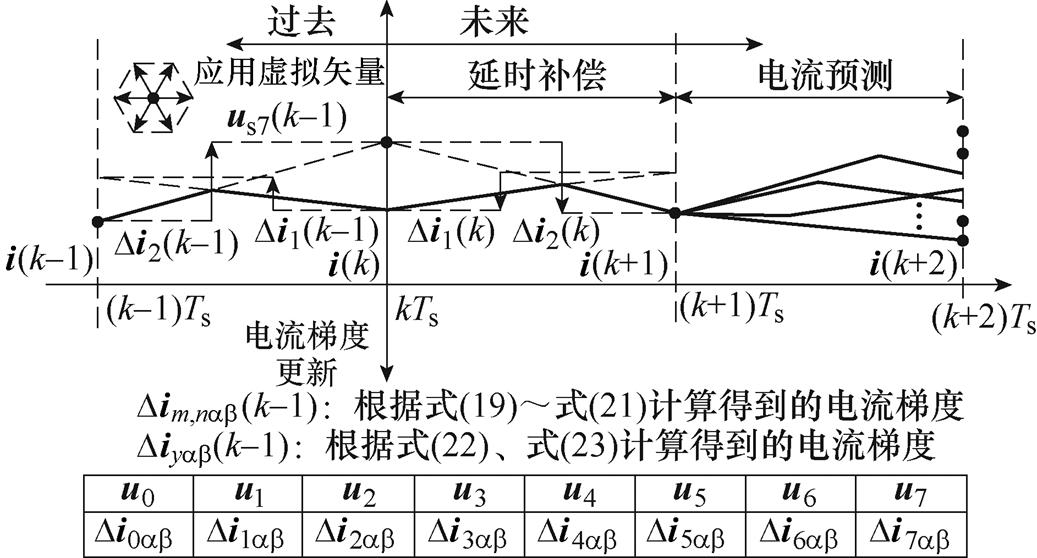
图3 所提电流梯度更新方法
Fig.3 The proposed current gradient updating method
图4为所提出的DV-MFPCC的控制框图,该方法主要由电流梯度更新、电流预测、价值函数评估和脉冲调制信号生成四部分组成。图5为所提出的DV-MFPCC方法的实现过程。
本节通过Matlab/Simulink仿真和实验验证了所提方法的有效性。图6为并网逆变器实验平台,其包括直流电压源、三相并网逆变器、滤波电感和交流电压源。所有控制方案均在TMS320F28335中实现,系统和控制参数见表1。示波器型号为LeCroy- HDO4034;电流探头型号为LeCroy-CP150;电网模拟器型号为Chroma-61830,用于模拟电网输出的交流电压。

图4 所提DV-MFPCC控制框图
Fig.4 Control block diagram of proposed DV-MFPCC
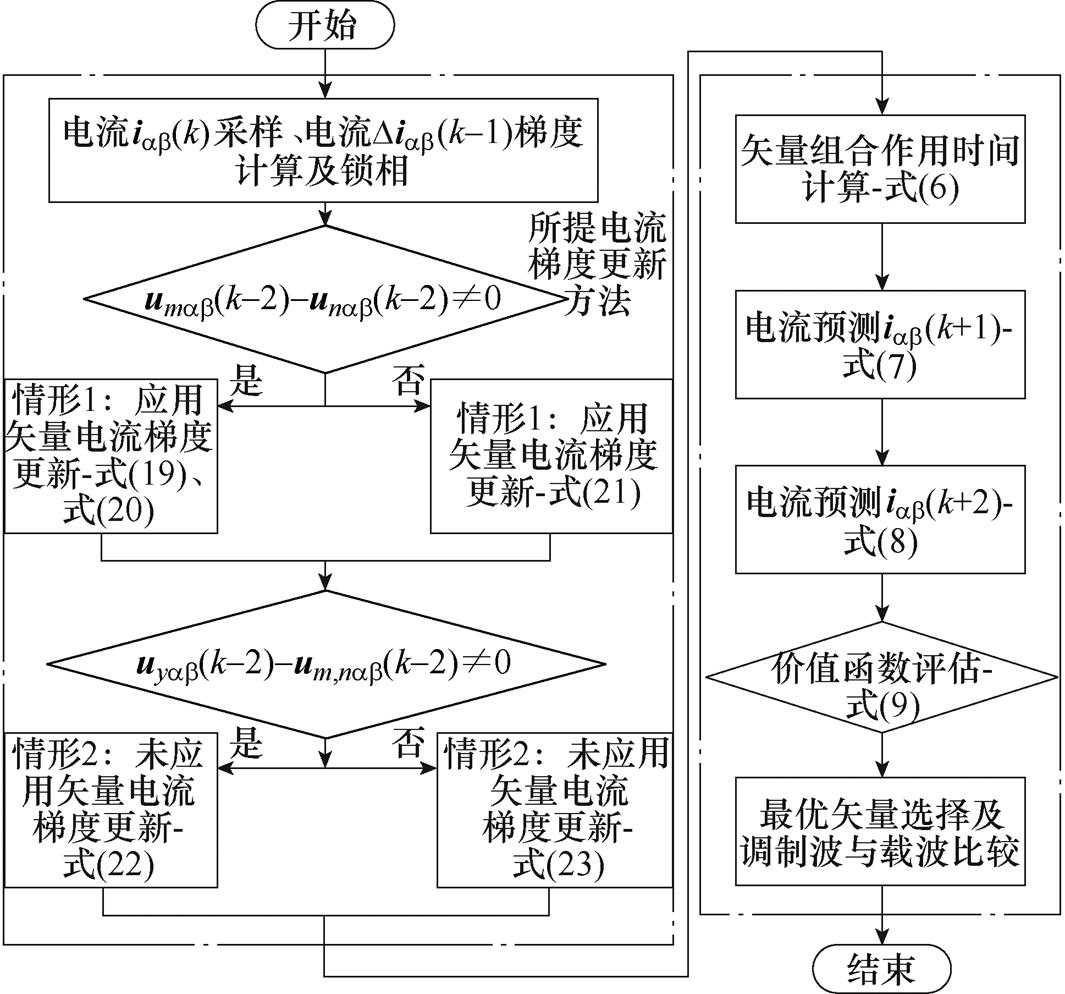
图5 所提DV-MFPCC实现过程
Fig.5 Implementation process of proposed DV-MFPCC
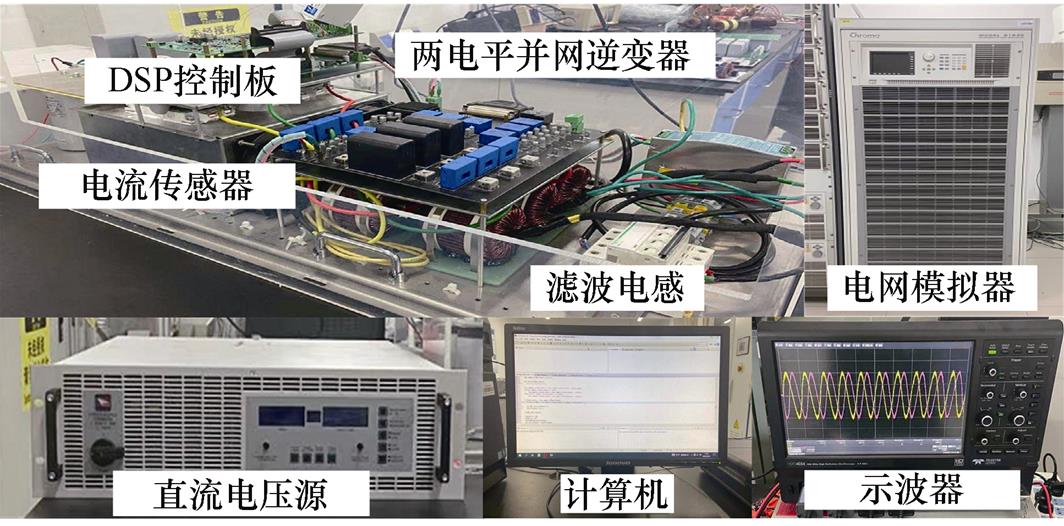
图6 并网逆变器实验平台
Fig.6 Grid-connected inverter experimental platform
表1 三相电压源逆变器系统和控制参数
Tab.1 System and control parameters of three phase inverter

参 数数 值 直流侧电压udc/V300 直流侧电容Cdc/mF1 400 电网相电压峰值e/V100 电网频率f/Hz50 滤波电感L0/mH8 寄生电阻R/W0.05 死区时间td/ms0.8
图7为文献[10]中电流梯度更新方法、文献[13]中电流梯度更新方法和所提更新方法的仿真结果。图7a为文献[10]更新方法下的电流梯度波形,在该方法中,每个控制周期仅更新应用电压矢量的电流梯度,而剩余的电流梯度保持上一个控制周期的旧值。如图7b所示,当使用文献[13]中的更新方法时,停滞现象减少。然而,Dia 和Dib 中的停滞现象无法完全消除。图7c为所提更新方法的电流梯度波形,可以看出,所有电压矢量的电流梯度在每个控制周期都会更新,更新停滞现象完全消除。其中,在a 轴中有5条曲线,在b 轴中有3条曲线,这是因为Di2a=Di6a,Di3a=Di5a,Di0a=Di7a,Di2b=Di3b,Di5b=Di6b及Di0b=Di7b=Di4b=Di1b。
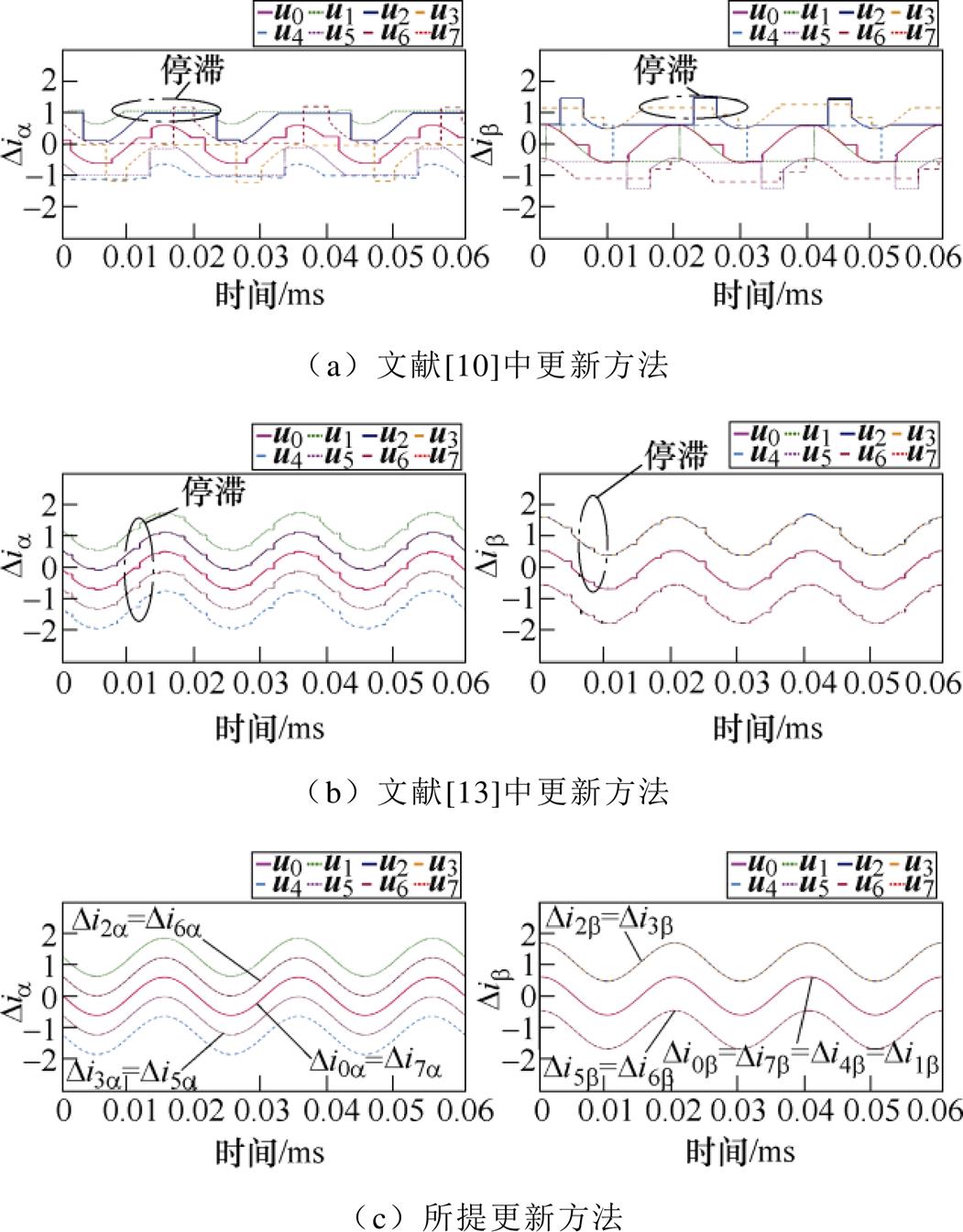
图7 不同更新方法下的电流梯度
Fig.7 Current gradient under different updating methods
3.2.1 稳态性能验证
图8比较了文献[13]中的SV-MFPCC、文献[16]中的DV-MPCC和所提DV-MFPCC的稳态电流性能、电流预测误差以及动态响应,参考电流由5 A突变为10 A。如图8a所示,当SV-MFPCC被实施时,其输出电流THD由9.73 %降低到4.74 %。如图8b所示,当DV-MPCC被实施时,其输出电流THD由5.83 %降低为2.87 %。如图8c所示,所提方法的输出电流THD由6.10 %降低为3.03 %。与SV-MFPCC相比,所提方法由于每个控制周期应用两个矢量,有效改善了电流性能;与DV-MPCC相比,所提方法的THD在参数准确时略高于DV-MPCC,这是因为所提方法的电流性能依赖于电流采样的准确性,而在实验过程中,因为电流采样噪声的存在,使得所提方法的输出电流THD略高于传统DV-MPCC方法,因此导致了更高的THD。此外,三种方法具有相近的动态响应速度。

图8 参数准确时电流纹波、THD及预测误差比较
Fig.8 Comparison of current ripple, THD and prediction error when parameters are accurate
3.2.2 鲁棒性能验证
图9比较了参数失配时文献[16]中的DV-MPCC和所提DV-MFPCC的电流纹波、THD以及预测误差。其中,电流THD的计算范围为0~50 kHz。由图9a和图9b可以看出,当电感的控制参数由8 mH变为4 mH(即0.5L0)时,DV-MPCC的THD由2.87 %增长到4.61 %,而所提DV-MFPCC方法不受参数的影响,THD保持为3.03 %,与DV-MPCC方法相比降低了1.58 %。由图9c可以看出,当电感的控制参数由8 mH变为16 mH(即2L0)时,DV-MPCC方法THD由2.87 %增长到3.21 %。与DV-MPCC相比,所提方法的THD降低了0.18 %。该实验结果验证了所提方法不受参数变化的影响,具有良好的参数鲁棒性。
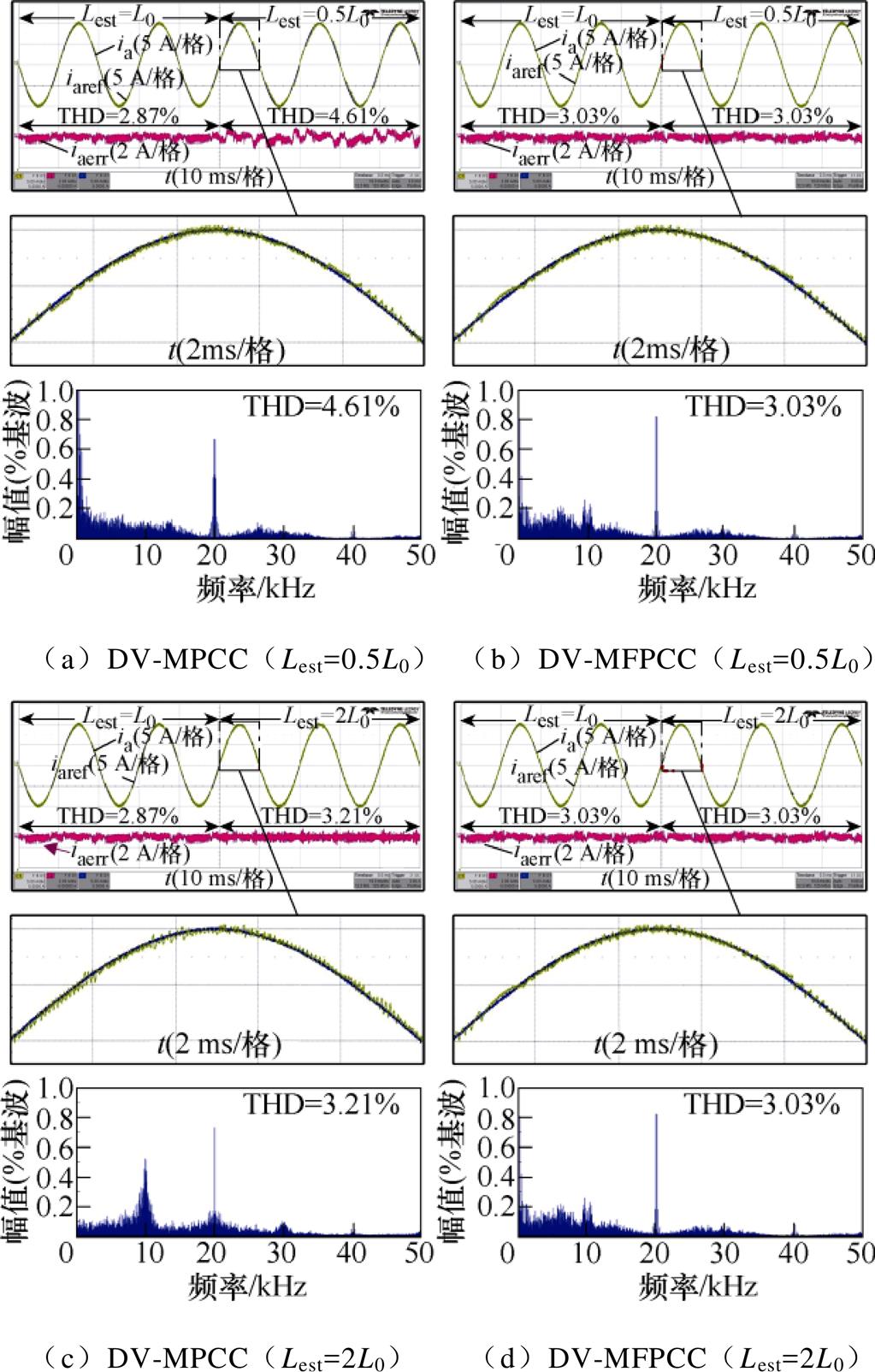
图9 参数失配时电流性能比较
Fig.9 Current performance comparison when parameter mismatches
3.2.3 电流梯度更新验证
为了有效地比较不同更新方法对电流性能的影响,文献[10, 13]中的更新方法被应用在双矢量的条件下并与所提更新方法进行比较。如图10a所示,由于文献[10]中的更新方法仅更新应用矢量作用下的电流梯度,因此图中存在明显的停滞现象,长时间的停滞现象会导致电流纹波中出现的电流尖峰频率较高,幅值较大。如图10b所示,当实施文献[13] 中的更新方法时,电流尖峰出现频率和幅值随着停滞现象的改善有效降低,预测误差也随之降低,由于停滞现象不能完全消除,电流尖峰仍然存在。与文献[10, 13]的更新方法相比,所提方法完全消除了停滞现象,因此其电流纹波和电流预测误差最低,电流尖峰完全消除,验证了所提更新方法的有效性。
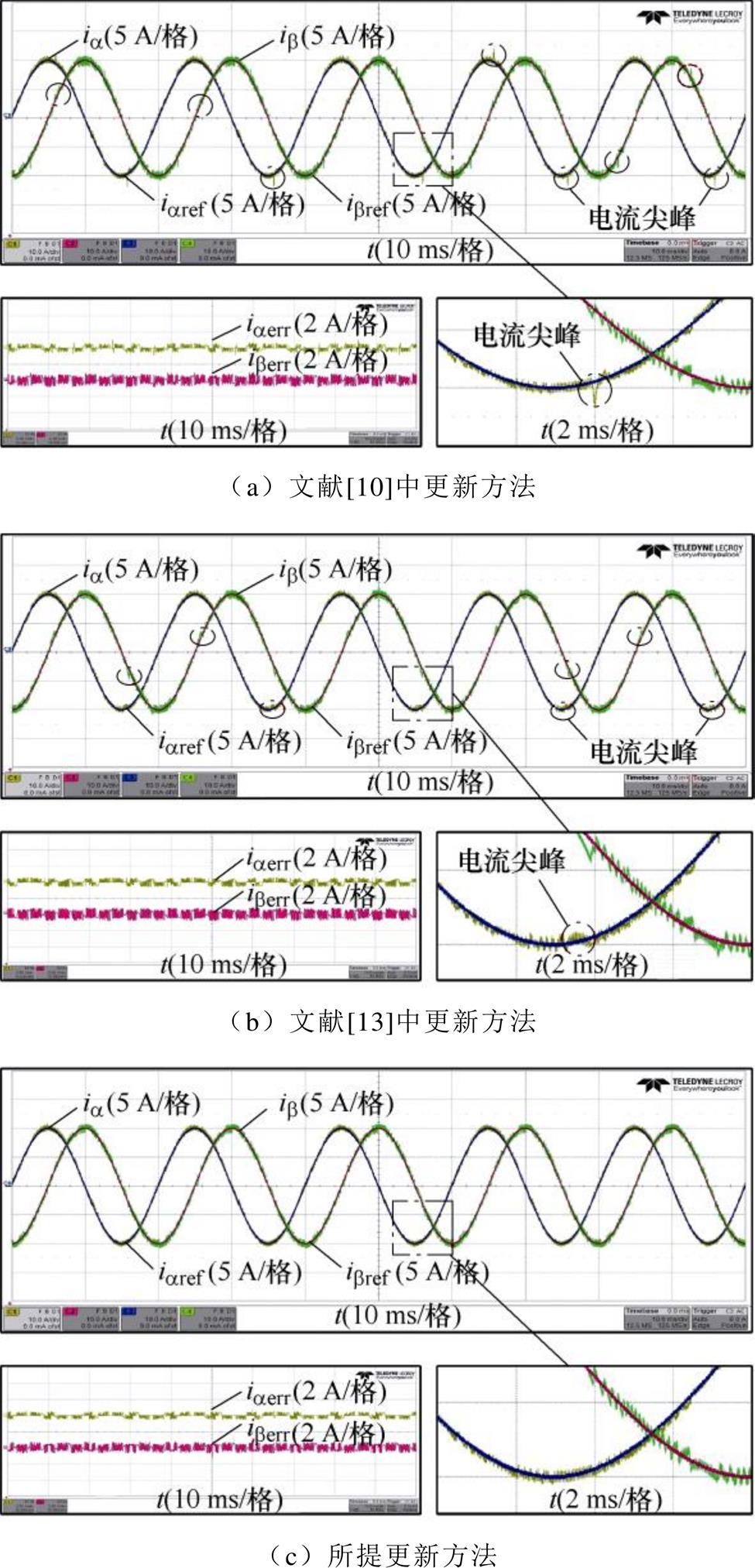
图10 不同更新方法下的电流性能比较
Fig.10 Current performance comparison under different updating methods
本文提出了一种基于电流梯度全更新的双矢量MFPCC方法,并在三相并网逆变器平台进行实验测试。结果表明,所提方法具有以下优点:
1)该方法在每个控制周期内使用两个电压矢量,减小了输出电流的纹波和THD。
2)它不依赖于任何模型参数,具有良好的参数鲁棒性,并在参数准确的条件下实现了与双矢量MPCC相近的控制性能。
3)该方法提出了一种先进的电流梯度更新方法,完全消除了电流梯度停滞现象及其导致的电流尖峰,进一步改善了电流质量。
后续研究可以通过改进矢量组合实现MFPCC固定开关频率控制,以进一步减小电流纹波;并将所提方法应用于含LC或LCL滤波的并网逆变器中,进一步研究多变量耦合下并网逆变器输出电流的参数鲁棒性问题。
参考文献
[1] 陈杰, 章新颖, 闫震宇, 等. 基于虚拟阻抗的逆变器死区补偿及谐波电流抑制分析[J]. 电工技术学报, 2021, 36(8): 1671-1680.
Chen Jie, Zhang Xinying, Yan Zhenyu, et al. Dead- time effect and background grid-voltage harmonic suppression methods for inverters with virtual impedance control[J]. Transactions of China Electro- technical Society, 2021, 36(8): 1671-1680.
[2] 陈琢, 王琛琛, 成前. 基于单一矢量的两电平逆变器快速模型预测控制[J]. 电工技术学报, 2021, 36(增刊2): 654-664, 687.
Chen Zhuo, Wang Chenchen, Cheng Qian. Fast model predictive control of two-level inverter based on single vector[J]. Transactions of China Electrotech- nical Society, 2021, 36(S2): 654-664, 687.
[3] 辛业春, 王延旭, 李国庆, 等. T型三电平并网逆变器有限集模型预测控制快速寻优方法[J]. 电工技术学报, 2021, 36(8): 1681-1692.
Xin Yechun, Wang Yanxu, Li Guoqing, et al. Finite control set model predictive control method with fast optimization based on T-type three-level grid- connected inverter[J]. Transactions of China Electro- technical Society, 2021, 36(8): 1681-1692.
[4] 徐伟, 董定昊, 葛健, 等. 基于在线参数辨识补偿的直线感应电机低开关频率模型预测控制策略[J]. 电工技术学报, 2022, 37(16): 4116-4133.
Xu Wei, Dong Dinghao, Ge Jian, et al. Low switching frequency model predictive control strategy based on online parameter identification compensation of linear induction motor for urban rail application[J]. Transa- ctions of China Electrotechnical Society, 2022, 37(16): 4116-4133.
[5] Zhang Yongchang, Li Bingyu, Liu Jie. Online indu- ctance identification of a PWM rectifier under unba- lanced and distorted grid voltages[J]. IEEE Transa- ctions on Industry Applications, 2020, 56(4): 3879- 3888.
[6] Guo Leilei, Xu Zhiye, Li Yanyan, et al. An indu- ctance online identification-based model predictive control method for grid-connected inverters with an improved phase-locked loop[J]. IEEE Transactions onTransportation Electrification, 2022, 8(2): 2695- 2709.
[7] Zhang Xiaoguang, Zhang Liang, Zhang Yongchang. Model predictive current control for PMSM drives with parameter robustness improvement[J]. IEEE Transactions on Power Electronics, 2019, 34(2): 1645-1657.
[8] Mousavi M S, Alireza Davari S, Nekoukar V, et al. A robust torque and flux prediction model by a modified disturbance rejection method for finite-set model- predictive control of induction motor[J]. IEEE Transactions on Power Electronics, 2021, 36(8): 9322-9333.
[9] Xiong Cong, Xu Haiping, Guan Tao, et al. A constant switching frequency multiple-vector-based model predictive current control of five-phase PMSM with nonsinusoidal back EMF[J]. IEEE Transactions on Industrial Electronics, 2020, 67(3): 1695-1707.
[10] Lin Chengkai, Liu Tianhua, Yu J T, et al. Model-free predictive current control for interior permanent- magnet synchronous motor drives based on current difference detection technique[J]. IEEE Transactions on Industrial Electronics, 2014, 61(2): 667-681.
[11] Lin Chengkai, Yu J T, Lai Y S, et al. Improved modelfree predictive current control for synchronous reluctance motor drives[J]. IEEE Transactions on Industrial Electronics, 2016, 63(6): 3942-3953.
[12] Carlet P G, Tinazzi F, Bolognani S, et al. An effective model-free predictive current control for synchronous reluctance motor drives[J]. IEEE Transactions on Industry Applications, 2019, 55(4): 3781-3790.
[13] Ma Chenwei, Li Huayu, Yao Xuliang, et al. An improved model-free predictive current control with advanced current gradient updating mechanism[J]. IEEE Transactions on Industrial Electronics, 2021, 68(12): 11968-11979.
[14] Almazan A C, Yu J T, Cheng Yushan, et al. Model- free predictive current control for SynRM drives based on optimized modulation of triple-voltage- vector[J]. IEEE Access, 2021, 9: 130472-130483.
[15] Almazan Agustin C, Yu J T, Lin Chengkai, et al. Triple-voltage-vector model-free predictive current control for four-switch three-phase inverter-fed SPMSM based on discrete-space-vector modulation[J]. IEEE Access, 2021, 9: 60352-60363.
[16] 郭磊磊, 金楠, 李琰琰, 等. 并网逆变器无电网电压传感器模型预测控制[J]. 电工技术学报, 2020, 35(12): 2612-2622.
Guo Leilei, Jin Nan, Li Yanyan, et al. Grid voltage sensorless model predictive control for grid- connected inverters[J]. Transactions of China Elec- trotechnical Society, 2020, 35(12): 2612-2622.
[17] 郭磊磊, 李国昊, 金楠, 等. 两电平电压源逆变器双矢量调制模型预测控制: 理论分析、实验验证和推广[J]. 电工技术学报, 2021, 36(1): 39-49.
Guo Leilei, Li Guohao, Jin Nan, et al. Two-vector- based modulated model predictive control method for 2-level voltage source inverters: theoretical analysis, experimental verification and extension[J]. Transa- ctions of China Electrotechnical Society, 2021, 36(1): 39-49.
Abstract Grid-connected inverters are crucial interfaces in renewable energy systems, such as photo- voltaic power generation systems, wind power generation systems, and energy storage systems. In order to improve the system performance, it is important to regulate the output current of an inverter with a small ripple and low total harmonic distortion (THD) to meet grid connection requirements. Model predictive current control (MPCC) schemes have been well developed in grid-connected inverters due to many advantages, such as high-speed response, straightforward constraint handling, multi-objective control capability, and simple implementation. However, their performances are affected by the accuracy of system parameters. Recently, a model-free predictive current control (MFPCC) scheme based on look-up tables (LUTs) has been reported for permanent magnet synchronous motors, where sixteen current gradients generated by eight basic voltage vectors are stored and updated for current predictions. Compared to the MPCC schemes, MFPCC schemes do not require system models and can be easily implemented. This conventional scheme only updates the current gradient of the applied voltage vector in each control period which causes long stagnation and large current ripple and THD. This paper proposes a double-vector MFPCC (DV-MFPCC) scheme to deal with the issues arising from conventional MFPCC schemes.
Firstly, the proposed scheme can reduce current ripple and THD due to the utilization of two voltage vectors. The duration of two voltage vectors is calculated based on the principle that they are inversely proportional to the cost function. Furthermore, an advanced and simplified current gradient updating method is proposed to eliminate the stagnation effect and reduce the calculation burden. The current gradients of the two voltage vectors are calculated based on the durations of the two. Other current gradients of the remaining six voltage vectors are updated by establishing a relationship of current gradients.
Simulation results on the current gradient updating show that when the proposed DV-MFPCC scheme is applied,the stagnation effect is eliminated because the current gradients for all the vectors are updated in each control period. There are five curves under a-axis and three curves under b-axis since Di2a=Di6a, Di3a=Di5a, Di0a=Di7a, Di2b=Di3b, Di5b=Di6b and Di0b=Di7b=Di4b=Di1b. Experimental results on the proper model parameters show that the THD of the output current is reduced from 9.73 % to 4.74 % for the SV-MFPCC, the THD of the output current is reduced from 5.83 % to 2.87 % for the DV-MPCC, and the THD is reduced from 6.10 % to 3.03 % for the proposed scheme. As a result, the performance is verified similarly to the DV-MPCC and better than the SVV-MFPCC. Experimental results on the inaccurate model parameters show that when the controller parameter mismatches the actual parameter, the proposed DV-MFPCC produces a smaller THD than the DV-MPCC. Hence, the parameter robustness of the proposed scheme can be verified. Experimental results on thedifferent updating methods show that the proposed updating method can improve current performance effectively.
The following conclusions can be drawn from the simulation and experimental analysis: (1) Two voltage vectors are utilized in each control period to reduce the ripple and THD of the output current. (2) It is independent of model parameters and avoids the influence of parameter mismatches, achieving similar control performance to DV-MPCC with accurate model parameters. (3) An advanced current gradient updating method with simple calculation is applied to eliminate the stagnation effect.
In future work, it is necessary to achieve the fixed switching frequency control, further reduce current ripples based on some advanced algorithms, and apply the proposed MFPCC in the higher-order system and multi-level inverter system.
keywords:Grid-connected inverter, model-free predictive current control, double-vector, current gradient updating
国家自然科学基金(52207184)、安徽省科技重大专项(202103a05020019)和安徽省自然科学基金杰青(2108085J24)资助项目。
收稿日期 2022-07-28
DOI: 10.19595/j.cnki.1000-6753.tces.221461
中图分类号:TM464
芮 涛 男,1990年生,讲师,研究方向为基于数据驱动的并网逆变器无参数预测控制技术。E-mail: 19057@ahu.edu.cn
尹 政 男,1996年生,硕士研究生,研究方向为变流器的调制与控制技术。E-mail: yz@stu.ahu.edu.cn(通信作者)
改稿日期 2022-08-22
(编辑 崔文静)